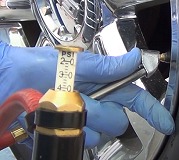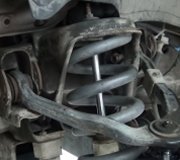I don't think you're looking at a performance issue. You're after ride quality. Wider tires provide more contact area with the ground. With more internal area to hold up a given amount of weight, you need less air pressure than with a skinnier tire. Lower air pressure allows the tire to squat more and flatten out, thereby increasing the contact patch even more. That's fine for the rear.
There's two problems with doing that on the front. First of all you're physically turning those tires with the steering system and the tires have to scrub across the road surface. Turning becomes very difficult at lower speeds. On the race track that isn't a problem at higher speeds, plus the tires lean to the left for oval-track racing so they're only riding on one edge most of the time. Still, ask those guys why they're worn out after a 500 mile race. All they did for a few hours is push a few pedals and turn the steering wheel. Wider tires on the front have the same affect on a passenger car. You don't need the same extreme cornering ability as a race car. All wider front tires would do is make your arms tired.
The second problem is ride quality. Even though people like to think they're driving a race car on the road, they still demand comfort. As the front tires get wider you start to feel more and more twigs, pebbles, and other bumps in the road. Those jar the steering system enough for you to feel in the steering wheel. My first experience with wide front tires was test-driving a late '70s Pontiac Firebird after performing an alignment on it. That was the most miserable handling car I had ever driven and I couldn't imagine having to drive it for long distances. Years later I put fat wheels and tires on my Plymouth Barracuda. That car also become no fun to drive.
As a side note, the engineers are also concerned with lowering weight for better fuel mileage. In the late '70s Chrysler started making their brake master cylinders out of aluminum instead of cast iron to save weight. It was that big of a deal to them. Since then all manufacturers are using thinner sheet metal, styrofoam bumper forms, alloy wheels, and considerably lighter suspension components. A heavy front tire and wheel will get thrown around more when they don't have the old, heavy control arms to help dampen that bouncing. You may feel the added reaction to road bumps with wider tires on the front and interpret that is "better road feel". Other people might interpret that as a busy steering system that is not enjoyable to drive.
The automotive business is extremely competitive. If a manufacturer can claim one extra horsepower, one more inch of leg room, or one more mile per gallon, they are going to do whatever they need to so they can do that. Styling and perception also account for a lot of sales. If wider rear tires are appealing they will offer a car model with wider rear tires.
With skinnier tires on the rear you may want to experiment with air pressure to see how it affects handling. The average driver wouldn't notice "decreased over steer" because that is not part of a normal driving condition. Over steer is a product of rear tires slipping. You changed the front tires and went back to what the engineers designed the car to use. Unless you're running a timed obstacle course, it's doubtful anyone is going to notice the difference. You're the one driving the car before and after the tire change, so you're the one who would notice the difference in handling. Where and how are you driving that you need to reach the limits of the car's handling abilities?
Thursday, August 22nd, 2013 AT 1:50 PM




